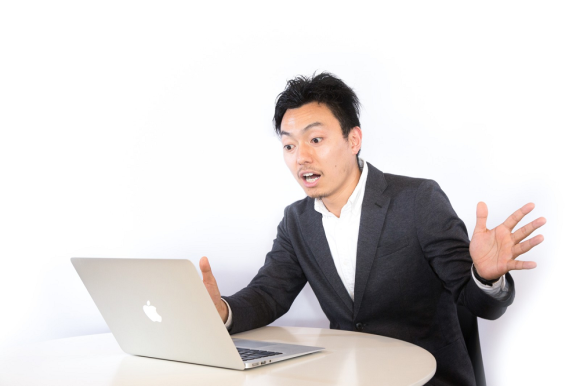
Hand cramps and style cramps are both part of job-hunting in Japan.
For foreign students looking for jobs in Japan, there’s more than just the local language to adapt to. Over the years, Japanese companies have developed certain norms in how they handle recruiting, and while they may seem natural to job-hunters who grew up in the culture, they can be startling for those who didn’t come to Japan until starting college.
With summer being the peak of the recruiting period in Japan, a seminar was recently held in Tokyo for students hailing from Southeast Asian nations who’re looking for employment, where some of the attendees spoke out about things they find strange about job-hunting in Japan.
1. Filling out forms by hand
In many countries, a hiring manager’s first instinct would be to toss a hand-written resume straight into the trash can, since adults are generally expected to know how to use a word processor. In Japan, though, taking the time to write your resume by hand conveys your deep respect for the position the company is recruiting for, and the same goes for filling out the official application. Even if you’ve downloaded the application as a PDF, you’re not supposed to type your information, but to grab a pen and carefully write out each word.
Oh, and as a matter of course, the resume shouldn’t just be hand-written, but written with excellent penmanship, once again as proof of how seriously you’ll be taking the job should it be offered to you.
2. A uniform appearance
While anything goes for street fashion in Japan, business attire is another story. Working professionals in Japan tend to dress both more formally and more conservatively than their overseas counterparts, and as an extension of that, job-hunters are expected to wear suits with extremely basic styles. As a matter of fact, plain black suits are so strongly associated with students seeking employment that they’re marketed as “recruit suits” by retailers in Japan.
The “basic black” logic applies to hair as well. Dyed hair will raise eyebrows and lower your chances of getting the job, and styling should be simple and neat, generally meaning short and trimmed for men and tied back in a ponytail for women.
While there’s at least a little bit of Japan’s conformist sentiments at play here, an arguably drab appearance also symbolizes an understanding that college is winding down and it’s time to get to work. After going to middle and high schools with strict dress codes and uniforms, college is considered a brief window in the life of Japanese people where they’re allowed to dress and look pretty much however they want, so a prim and proper appearance at an interview shows an understanding that the applicant is ready to grow up.
3. Group interviews
Large Japanese companies often do their recruiting in large, single batches annually, almost like a school enrolling new students. With so many applicants vying for the same classification of jobs, some companies streamline the process by conducting group interviews in early round of the process.
But even if everyone in a group interview gets asked the same questions, not everyone has an answer. One frustrated foreign student spoke of going to a group interview where applicants were asked to talk about their experience in leadership roles. Some of the applicants proudly told stories of when they’d acted as leaders in school activities or at their part-time jobs, but those without such experiences had nothing to contribute, and so had to sit by silently until the next question.
4. Not knowing what kind of work you’ll be doing
While this isn’t true for every position in Japan, sometimes companies recruit for what’s called sogoshoku, or “comprehensive work.” What that means is that once hired, you’ll periodically assist or be rotated to various departments within the company.
On the plus side, that can help new recruits see how the company works as a whole, and also lets them acquire a wide range of skills and figure out what sort of day-to-day work they have an interest in and aptitude for. At the same time, it can be unnerving to apply for a job without knowing what your exact responsibilities are going to be.
If some of the items on this list don’t sit right with you, there’s something important to keep in mind. Though these are all aspects of how Japanese companies do their ordinary recruiting, things can be very different for positions or divisions with an international focus, and in such cases there’s usually a bit more flexibility in the job-hunting process (especially in the area of hand-written resumes). However, if you’re planning to throw your hat into the general recruiting ring, and compete against Japanese job-hunters for a position, you’ll have the best chance of success if you play by the local rules.
Source: Yahoo! Japan News/withnews via Jin
Top image: Pakutaso
Insert images: Pakutaso (1, 2)
Casey doesn’t write his tweets by hand or wear a suit when sending them, but you can follow him on Twitter anyway.



 Foreigners in Japan sound off on the top four quirks of the Japanese job-hunting system
Foreigners in Japan sound off on the top four quirks of the Japanese job-hunting system “Face Hiring”: Japanese cosmetics company Isehan’s new hiring campaign is causing a stir
“Face Hiring”: Japanese cosmetics company Isehan’s new hiring campaign is causing a stir Japanese ministers call for reform of company hiring practices that focus on new graduates
Japanese ministers call for reform of company hiring practices that focus on new graduates Pantene ad asks why people in Japan are forced to look the same when job hunting
Pantene ad asks why people in Japan are forced to look the same when job hunting Japanese clothing chain offers an answer to job-hunting suit conundrum
Japanese clothing chain offers an answer to job-hunting suit conundrum Red light district sushi restaurant in Tokyo shows us just how wrong we were about it
Red light district sushi restaurant in Tokyo shows us just how wrong we were about it McDonald’s new Happy Meals offer up cute and practical Sanrio lifestyle goods
McDonald’s new Happy Meals offer up cute and practical Sanrio lifestyle goods Japan’s massive matcha parfait weighs 6 kilos, contains hidden surprises for anyone who eats it
Japan’s massive matcha parfait weighs 6 kilos, contains hidden surprises for anyone who eats it Anime girl English teacher Ellen-sensei becomes VTuber/VVTUber and NFT
Anime girl English teacher Ellen-sensei becomes VTuber/VVTUber and NFT Sandwiches fit for a sumo served up in Osaka【Taste Test】
Sandwiches fit for a sumo served up in Osaka【Taste Test】 Historical figures get manga makeovers from artists of Spy x Family, My Hero Academia and more
Historical figures get manga makeovers from artists of Spy x Family, My Hero Academia and more Studio Ghibli releases new action figures featuring Nausicaä of the Valley of the Wind characters
Studio Ghibli releases new action figures featuring Nausicaä of the Valley of the Wind characters All-you-can-drink Starbucks and amazing views part of Tokyo’s new 170 meter-high sky lounge
All-you-can-drink Starbucks and amazing views part of Tokyo’s new 170 meter-high sky lounge Kyoto’s 100 Demons yokai monster parade returns!
Kyoto’s 100 Demons yokai monster parade returns! Japanese ramen restaurants under pressure from new yen banknotes
Japanese ramen restaurants under pressure from new yen banknotes French Fries Bread in Tokyo’s Shibuya becomes a hit on social media
French Fries Bread in Tokyo’s Shibuya becomes a hit on social media New private rooms on Tokaido Shinkansen change the way we travel from Tokyo to Kyoto
New private rooms on Tokaido Shinkansen change the way we travel from Tokyo to Kyoto Studio Ghibli glasses cases let anime characters keep an eye on your spectacles
Studio Ghibli glasses cases let anime characters keep an eye on your spectacles Tokyo Tsukiji fish market site to be redeveloped with 50,000-seat stadium, hotel, shopping center
Tokyo Tsukiji fish market site to be redeveloped with 50,000-seat stadium, hotel, shopping center Beautiful Ghibli sealing wax kits let you create accessories and elegant letter decorations【Pics】
Beautiful Ghibli sealing wax kits let you create accessories and elegant letter decorations【Pics】 Studio Ghibli releases Kiki’s Delivery Service chocolate cake pouches in Japan
Studio Ghibli releases Kiki’s Delivery Service chocolate cake pouches in Japan New definition of “Japanese whiskey” goes into effect to prevent fakes from fooling overseas buyers
New definition of “Japanese whiskey” goes into effect to prevent fakes from fooling overseas buyers Our Japanese reporter visits Costco in the U.S., finds super American and very Japanese things
Our Japanese reporter visits Costco in the U.S., finds super American and very Japanese things Studio Ghibli unveils Mother’s Day gift set that captures the love in My Neighbour Totoro
Studio Ghibli unveils Mother’s Day gift set that captures the love in My Neighbour Totoro New Japanese KitKat flavour stars Sanrio characters, including Hello Kitty
New Japanese KitKat flavour stars Sanrio characters, including Hello Kitty More foreign tourists than ever before in history visited Japan last month
More foreign tourists than ever before in history visited Japan last month New Pokémon cakes let you eat your way through Pikachu and all the Eevee evolutions
New Pokémon cakes let you eat your way through Pikachu and all the Eevee evolutions Sales of Japan’s most convenient train ticket/shopping payment cards suspended indefinitely
Sales of Japan’s most convenient train ticket/shopping payment cards suspended indefinitely Sold-out Studio Ghibli desktop humidifiers are back so Totoro can help you through the dry season
Sold-out Studio Ghibli desktop humidifiers are back so Totoro can help you through the dry season Japanese government to make first change to romanization spelling rules since the 1950s
Japanese government to make first change to romanization spelling rules since the 1950s Ghibli founders Toshio Suzuki and Hayao Miyazaki contribute to Japanese whisky Totoro label design
Ghibli founders Toshio Suzuki and Hayao Miyazaki contribute to Japanese whisky Totoro label design Doraemon found buried at sea as scene from 1993 anime becomes real life【Photos】
Doraemon found buried at sea as scene from 1993 anime becomes real life【Photos】 Tokyo’s most famous Starbucks is closed
Tokyo’s most famous Starbucks is closed One Piece characters’ nationalities revealed, but fans have mixed opinions
One Piece characters’ nationalities revealed, but fans have mixed opinions We asked a Uniqlo employee what four things we should buy and their suggestions didn’t disappoint
We asked a Uniqlo employee what four things we should buy and their suggestions didn’t disappoint Princesses, fruits, and blacksmiths: Study reveals the 30 most unusual family names in Japan
Princesses, fruits, and blacksmiths: Study reveals the 30 most unusual family names in Japan To handwrite, or not to handwrite? Recruiter lays into ‘laziness’ of young Japanese job hunters
To handwrite, or not to handwrite? Recruiter lays into ‘laziness’ of young Japanese job hunters Window in life when Japanese people can act like individuals is depressingly short, tweet asserts
Window in life when Japanese people can act like individuals is depressingly short, tweet asserts New cosplay job-hunting site opens, offers everything from one-day to full-time positions
New cosplay job-hunting site opens, offers everything from one-day to full-time positions Japanese advertising company selling space on young women’s armpits, recruiting models【Photos】
Japanese advertising company selling space on young women’s armpits, recruiting models【Photos】 No gender, photo, or first name – Japanese company makes major shakeup to job application forms
No gender, photo, or first name – Japanese company makes major shakeup to job application forms Four frustrating attitudes women in Japan run into when interviewing for jobs, grouped by age
Four frustrating attitudes women in Japan run into when interviewing for jobs, grouped by age Social media users boast of plans to grope schoolgirls on day of Japan’s most important test
Social media users boast of plans to grope schoolgirls on day of Japan’s most important test Spend a shift working in a terrible, soul-crushing Japanese company at this “special” Tokyo event
Spend a shift working in a terrible, soul-crushing Japanese company at this “special” Tokyo event Man forgets the first rule of Japanese job interviews: Don’t steal the boss’ wallet
Man forgets the first rule of Japanese job interviews: Don’t steal the boss’ wallet New Pantene commercial interviews Japanese trans individuals about difficulties of job hunting
New Pantene commercial interviews Japanese trans individuals about difficulties of job hunting Japanese university says your girlfriend might dump you, other harsh truths in recruiting ad
Japanese university says your girlfriend might dump you, other harsh truths in recruiting ad “Be a blank slate”: The way to get hired in Japan?
“Be a blank slate”: The way to get hired in Japan? Japanese university globalizes with fall start date, governor wants English as official language
Japanese university globalizes with fall start date, governor wants English as official language All-boys’ high school in Japan has mandatory grooming lesson, teaches about skincare, hairstyling
All-boys’ high school in Japan has mandatory grooming lesson, teaches about skincare, hairstyling An interview with two Japanese dating service scam sakura【Interview】
An interview with two Japanese dating service scam sakura【Interview】
Leave a Reply